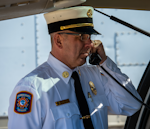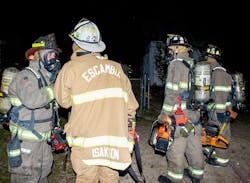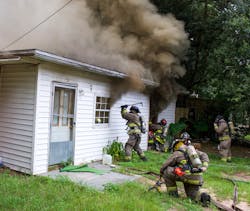Command & Control Success: All-Hands Operations—Depth on the Bench
Command success at an all-hands-working or multiple-alarm fire largely is based on having “depth on the bench.” In sports, having a deep bench means having a large number of very talented players. So, when used in the sports sense, a deep bench not only refers to a lot of candidates but to a lot of strong candidates. How does this translate to the fireground? Well, if there aren’t enough available companies that aren’t currently assigned to a fireground function that don’t have some type of fireground tactical proficiency, there is no depth on the bench. In the past, too many times at a serious working fire, there was in part a lack of understanding of the fireground commander (FGC) that all-hands-working meant calling for additional resources or a greater alarm sooner rather than later. Also, a lack of aggressive and quality-based tactics because of weak company performance requires the need for additional fire companies. You must have talented firefighters—and enough of them—to ensure command success. Tactics put out fires, and command manages these tactics using thought-out strategy from past experiences as an FGC.
Companies at the ready
I learned of the term “all-hands” years ago when I viewed a tape of a working fire that involved the FDNY at a multistory, multiple dwelling in Harlem. The fire took hold of an upper floor, and the 16th Battalion quickly reported an all-hands via the portable radio. Soon after, a second alarm was transmitted. I learned that “All-hands” over the radio let everyone know that the fire required all assigned resources to be committed prior to the arrival of second-alarm companies. There was no one on the bench standing by for the next necessary tactical assignment to support the FGC’s overall strategy.
The all-hands confirmation also signaled to the dispatcher and others who were listening that there was a good chance that more resources might be needed. This allowed other companies/chiefs and the dispatcher to possibly get a head start: Proactive chiefs, companies and dispatchers can prepare via move ups, likely cutting arrival time of additional resources.
It is critical for the FGC and other chiefs to have additional companies beyond those that are assigned to a specific task to be at the ready. The FGC must have additional resources standing fast if needed to stretch an additional line when fire jumps floors, extends to exposures or extends to void spaces, such as an attic via balloon-frame construction. Most importantly, the FGC needs a deep bench for the possible mayday situation that will require more than a two- or four-person RIT.
An example of such a situation is the Gloucester City, NJ, collapse on July 4, 2002, in which three New Jersey firefighters lost their life. The incident was dispatched at 1:35 a.m., and the building collapsed at 2:06 a.m., only 31 minutes after dispatch. All FGCs should study fires such as this one to not only learn from them but to be reminded that not every incident is routine. We shouldn’t get complacent, even when our standard response handles most fires. Any type of rapid-fire growth, extension of fire to exposures, structural collapse or missing or trapped firefighter rapidly will overwhelm the standard alarm assignment. It also will overwhelm the FGC if he/she doesn’t have other command officers to help manage the fireground. A majority of the fire service gets complacent thinking that one or two chiefs can properly manage an all-hands fire based on past experiences. It isn’t just your own past experiences but also studying and learning from others, so we don’t repeat history.More than one chief
Depth on the bench also involves additional command staff responding to and operating on the fireground.
I responded for years to fires over a large metropolitan county area as the only chief officer who was on duty. I commanded hundreds of fires/incidents as the only chief with very few of those incidents causing me any issues. This doesn’t make it acceptable nor does this mean that something couldn’t happen that would require two or more chiefs to properly command the incident. Luckily, over the past few years, I have had the addition of another chief responding to working fires and other significant incidents, which makes the depth of command greater. I feel much more comfortable and relaxed with this additional chief assisting me and vice versa. I am certain that having more than one chief to manage a fire/incident brings a higher level of safety and command confidence and raises the level of performance of most fire companies.
This, too, can be related to sports: having an offensive and defensive coordinator, each of whom focuses on a specific function or task. This allows the head coach—in our realm, the FGC—to step back and look at the big picture. The FGC can focus more on overall strategy rather than worry whether particular tactics are being completed properly and in a timely manner.
Recognizing the possibilities
I recently experienced what has been covered to this point at a multistory commercial fire in a mixed occupancy. I was the third-arriving chief to the fire and was assigned to assume operations/interior. The first-arriving chief established a stationary command post in the rear of the building on the C side. This was where the first-arriving engine and truck had positioned and also was the best command post location based on the building construction features and smoke conditions. It allowed the FGC to visibly see the building and the initial deployment of lines and ladders. The FGC also was able to immediately see the conditions change when the building was opened horizontally, where the initial attack line made entry. Further, he could see the first-arriving ladder company ascend the aerial to the roof and see the smoke from the vertical vent opening. Observing these ongoing size-up indicators assisted the FGC in determining the next tactical assignments for the remaining companies on the initial box alarm.
The second-arriving chief was assigned to the opposite side of the incident from the stationary command post. This actually was the street side and was designated as the A side, even though the command post was in the rear of the building.
Now, even with two chiefs operating on opposite sides of the fire, there still were a lot of companies and territory not covered: The front and the back were covered, but who was coordinating multiple companies on the interior and focusing on the progress or lack of progress.
As the third-arriving chief, and having been assigned to operations/interior, I went inside to evaluate interior conditions compared with exterior conditions. I also thought about what I observed during my 360, utilizing the buggy to drive around the large commercial complex, which had two large anchor stores, a two-story restaurant and a large number of retail stores. (I did this numerous times previously on larger complexes, where driving around the entire building is a lot more practical than being on foot.)
Once inside, I was able to get a better understanding of the layout as compared with the 360, and I took a look at the “You Are Here” map that hung on the wall just inside of the entry point.
This type of map was used at another fire at this same complex more than 10 years before by the chief in command of this fire, when he was the first-arriving company officer. He shared this nugget at the tailboard critique, and it was a great learning point. Tailboard critiques and incident reviews are critical for future success.
While on the interior—and not having to physically focus on a specific task or tactic—I was able to monitor five companies that operated numerous attack lines, pulled ceilings and conducted a search. This allowed the company officers to focus on their assigned task/tactic and allowed me to maintain crew accountability and to focus on overall progress. This fire had a large number of newer firefighters who were led by seasoned officers who worked in busy companies. The combination of experienced company officers and having a command officer on the interior allowed these officers to get more engaged while I monitored conditions and communicated with the FGC. This helped to balance the depth of the bench and assisted with command success. Some times command officers must be flexible based on staffing and experience. This was a situation where understanding the capabilities of your companies is critical. Not all fire companies are created equal, as I mentioned in my May 2020 column (firehouse.com/21131324).
Overall, command success depends on the FGC and other officers being realistic about what can be accomplished with the current available staffing and experience that they have in each situation. Always remember time-delayed tactics when you are understaffed and up against a challenging fire. Tactics put out fires!

Curt Isakson
Curt “Ike” Isakson is a 30-plus-year veteran of the fire service. He currently is a battalion chief for Escambia County, FL, Fire Rescue, where he has worked for the past 23 years. Isakson previously worked nine years for the Pensacola, FL, Fire Department, where he was assigned as a company officer on Heavy Rescue 31. His fire service experience started at a young age as a junior firefighter with the Midway, FL, Fire District; he rose through the ranks to captain. Isakson's identification of the need for a series of special-interest fire conferences spawned the development of County Fire Tactics, which covers officer development, command officers, water on fire, high-rise operations, and leadership and tactics.







